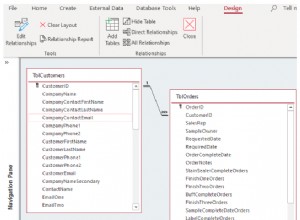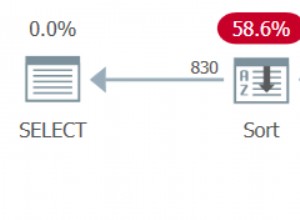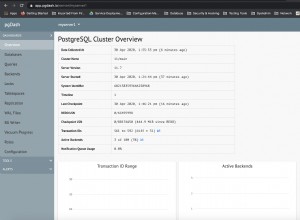Jest to możliwe, ale nie jestem pewien, jak długo potrwa to na twoim bardzo dużym stole. Zakładam, że możesz tworzyć nowe tabele zawierające wszystkie grupy i liczby, gdy kolumna grupy jest zapełniana.
Ponadto nie można tego uruchomić na stole na żywo. Nie da się tego napisać, więc nie jest to ograniczenie mojego projektu. Zastanów się, co by się stało, gdybyś dodał nowy wiersz z wartościami 7 i „6,7”, który połączyłby grupy 1 i 2, a cała praca musiałaby zostać porzucona.
Ten proces musi być uruchamiany ponownie za każdym razem, gdy pojawiają się dodatki do tabeli. Jeśli jest to nie do przyjęcia, uruchom go raz, a następnie zastąp go wyzwalaczami, które zachowują wartości i w razie potrzeby łączą grupy.
Oto procedura. Może skorzystać na pewnej modularyzacji, ale działa. Wziąłem Jay Pipes split_string funkcji i zawierał ją.
Najpierw DDL i trochę danych testowych
CREATE TABLE `company` (
`col1` int(11) DEFAULT NULL,
`col2` varchar(100) DEFAULT NULL,
`grp` int(11) DEFAULT NULL
);
CREATE TABLE `groups` (
`number` int(11) NOT NULL DEFAULT '0',
`grp` int(11) NOT NULL DEFAULT '0',
`processed` tinyint(1) DEFAULT NULL,
PRIMARY KEY (`number`,`grp`),
KEY `grp` (`grp`)
);
insert into company (col1, col2) values
(1,'2,3,4'),
(2,'5,6'),
(3,'1,2,5'),
(4,'7,8'),
(5,'11,3'),
(6,'22,8');
A teraz procedura
use test;
drop procedure if exists group_it;
delimiter //
create procedure group_it ()
begin
declare current_group int default 0;
declare ids varchar(100);
-- clear out all data from before
update company set grp = null;
truncate groups;
main: loop
-- take one unmapped (new group)
set ids := null;
select col2 into ids from company where grp is null limit 1;
if ids is null then
leave main;
end if;
set current_group := current_group + 1;
-- put each value into groups table and mark as unprocessed
call split_string(ids, ',');
insert into groups select value, current_group, false from SplitValues;
-- while unprocessed value in groups
begin
declare unprocessed int;
unprocessed: loop
set unprocessed = null;
select number
into unprocessed
from groups
where not processed
limit 1;
if unprocessed is null then
leave unprocessed;
end if;
begin
-- find all rows in company that matches this group
declare row_id int;
declare ids2 varchar(100);
declare cur2_done boolean;
declare cur2 cursor for
select col1, col2
from company
where col2 regexp concat('^', unprocessed, '$')
or col2 regexp concat('^', unprocessed, ',')
or col2 regexp concat(',', unprocessed, '$')
or col2 regexp concat(',', unprocessed, ',');
declare continue handler for not found set cur2_done := true;
open cur2;
numbers: loop
set cur2_done := false;
fetch cur2 into row_id, ids2;
if cur2_done then
close cur2;
leave numbers;
end if;
update company set grp = current_group where col1 = row_id;
-- add all new values to groups marked as unprocessed
call split_string(ids2, ',');
insert ignore into groups select value, current_group, false from SplitValues;
end loop numbers;
update groups set processed = true where number = unprocessed;
end;
end loop unprocessed;
end;
end loop main;
end//
delimiter ;
To jest Jay Pipes split_string
DELIMITER //
DROP PROCEDURE IF EXISTS split_string //
CREATE PROCEDURE split_string (
IN input TEXT
, IN `delimiter` VARCHAR(10)
)
SQL SECURITY INVOKER
COMMENT
'Splits a supplied string using using the given delimiter,
placing values in a temporary table'
BEGIN
DECLARE cur_position INT DEFAULT 1 ;
DECLARE remainder TEXT;
DECLARE cur_string VARCHAR(1000);
DECLARE delimiter_length TINYINT UNSIGNED;
DROP TEMPORARY TABLE IF EXISTS SplitValues;
CREATE TEMPORARY TABLE SplitValues (
value VARCHAR(1000) NOT NULL PRIMARY KEY
) ENGINE=MyISAM;
SET remainder = input;
SET delimiter_length = CHAR_LENGTH(delimiter);
WHILE CHAR_LENGTH(remainder) > 0 AND cur_position > 0 DO
SET cur_position = INSTR(remainder, `delimiter`);
IF cur_position = 0 THEN
SET cur_string = remainder;
ELSE
SET cur_string = LEFT(remainder, cur_position - 1);
END IF;
IF TRIM(cur_string) != '' THEN
INSERT INTO SplitValues VALUES (cur_string);
END IF;
SET remainder = SUBSTRING(remainder, cur_position + delimiter_length);
END WHILE;
END //
DELIMITER ;




